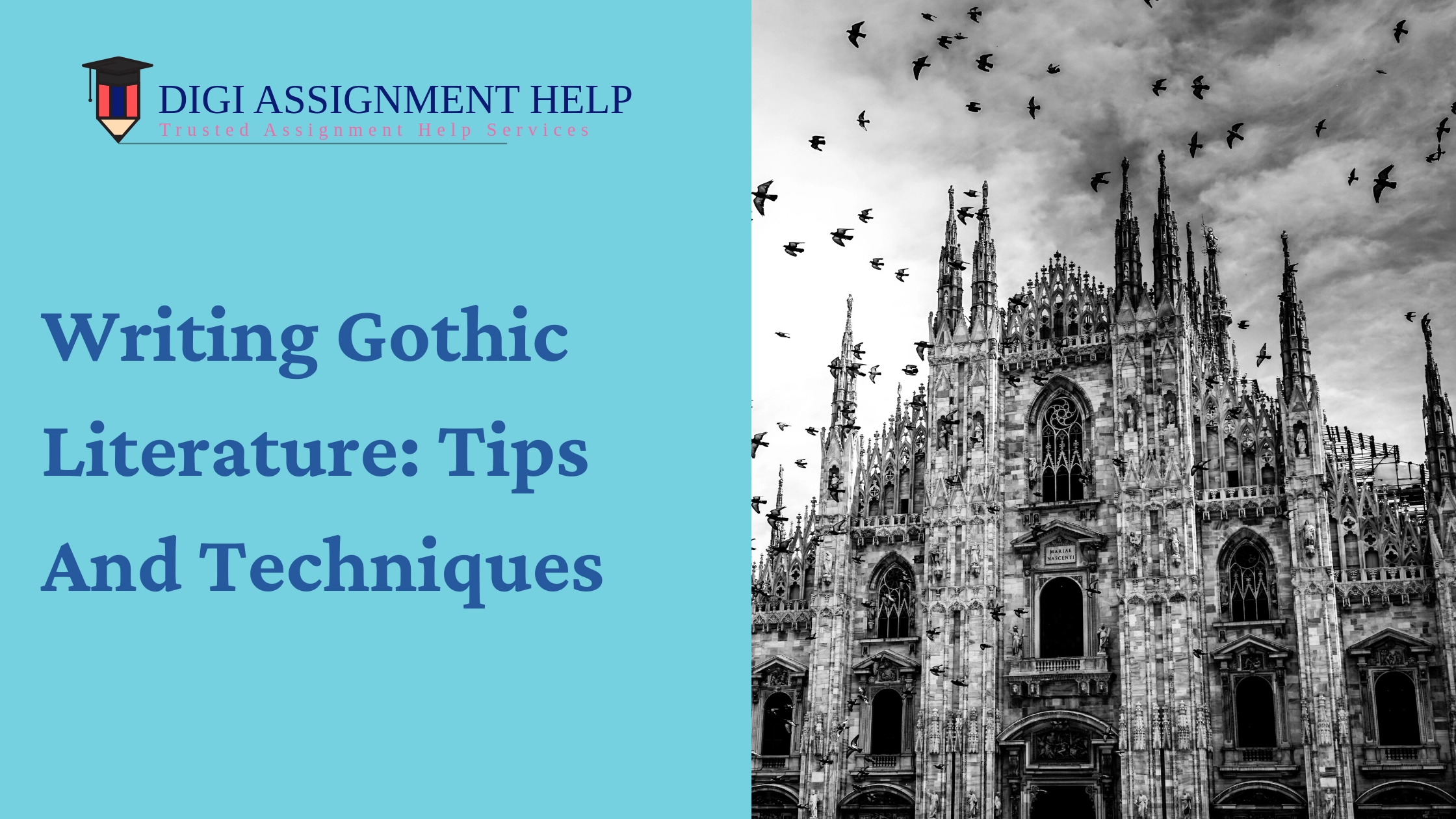Writing Gothic Literature: Tips and Techniques
 30-Aug-2024 05:59 AM
30-Aug-2024 05:59 AM

Gothic literature has been favoured by readers for long. It is well-loved for its eerie settings and themes. The mysterious characters further make them more fun to read. This sort of writing emerged in the 18th century. It blends romance, horror and the supernatural and explores the psyche of the human mind.
Writing gothic literature requires an understanding of the style. Once you get the basics, it doesn't matter if you are a beginner writer, you’ll be able to craft mysterious stories. In this blog, we explain step by step how you can write stories that will invoke horror and thrill.
1. Embrace the Gothic Setting
One of the main points to focus on is the setting. Remember these stories take place in dark, remote and decaying locations. For example, you have abandoned castles and monasteries. This adds chill in the air making them more ominous. Here is how you can make it effective:
-
Use descriptive language: Try to give your readers an image of the plot. Focus on sensory details. For example, tell what your characters are seeing and hearing. Your readers should be able to feel at level with the character.
-
Incorporate the weather: it helps describe the mood. For example, storms and fog are helpful in creating a dark atmosphere. They can also build tension in your story.
-
Reflect the character's inner turmoil: the setting should reflect the emotions of the character- what they are going through. For example, a crumbling castle might show the mental breakdown of the character.
2. Develop Complex Characters
This literature thrives on characters complex in nature. They have depth and dark pasts. These characters drive the narrative. They add more layers of suspense and keep the readers engaged. Here’s how you can do it:
-
Create flawed protagonists: the main character should have weaknesses and strengths. They should have inner demons but also the courage to handle them. For example, you can show how they are struggling with guilt or are haunted by their past actions.
-
Introduce a mysterious villain: the villain or the antagonist should be shrouded in mystery. The villain's motive should not be revealed at a go. He should hold some authority, or be a ghost seeking revenge. They could be stuck with some ancient curse or struggle with their powers.
-
Explore psychological depths: you should give depth to the depth. This is a good genre to explore madness, obsession and fear. Show how these psychological elements affect your characters. You can build a good plot based on their emotions.
3. Weave in supernatural elements
Supernatural is a keynote in the gothic element. It adds mystery and allows high imagination. It also adds to the storytelling and gives you more elements. For example, you can add a ghost or fictive creature like a mystic bird or bunny.
-
Subtlety is key: Supernatural elements allow your imagination to flow. However, it doesn’t mean that it should occupy the whole plot. Use them accordingly so that they blend effortlessly into the story.
Some of the ways to use them are unexplained noises, scary shadows, or the happenings of events without any logic. Unless you are writing a horror story, small events would work fine. -
Connect the Supernatural to the Plot: the supernatural aspects of the story should be about the story. They add much more to the story rather than just effects. By linking them to the story you can have a better .
For example you can link the curse to the characters. You can use it to establish some relationship between the main hero and the villain. Or you can tell the story of a ghost seeking justice. -
Create Ambiguity: Gothic literature frequently leaves readers wondering what is imagined and what is real. It allows for multiple interpretations of incidents.
This blurs boundaries between the supernatural and the natural world. Hence it is a factor that engages the audience more. It will keep the reader guessing.
4. Emphasis on Atmosphere and Mood
The Gothic genre relies heavily on atmosphere and mood. The description of the surroundings puts the reader in the dread of anticipation. It engages the readers more actively and they will feel like they are in the gothic world.
-
Set the Tone with Your Language: Choosing the right words to use can help to set the tone. Select words that have gloomy, depressing connotations.
You can go for Similes, symbols, and metaphors. Frame your references wisely and they will build the atmosphere. -
Pacing Is Important: Gothic literature sometimes has erratic pacing. This is done to invoke sudden surprise or thrill.
This is seen with peaceful passages followed by abrupt peaks in suspense or fear. Make use of this ebb and flow to maintain the reader's tension. -
Contrast Light and Dark: Gothic fiction frequently draws attention to the contrast of the two different worlds. This could be seen while describing the beauty of the scene or a character's appearance and the sinister underworld.
The atmosphere may become more suffocating and gloomy. This kind of writing makes the scene shocking and introduces dark elements.
5. Include Isolation and Decay Themes
Gothic literature frequently deals with themes of decay. It is characterised by physical and emotional isolation. This highlights the darker side of human existence. The literature aims to analyse this psyche of human behaviour.
-
Isolation: This work frequently features characters who are emotionally or physically alone. They will be seen shut up in a remote area or as being cut off from society.
These characters are not well accepted even if they try. This brings out an evil arc and their hatred for the world. This theme will help to highlight the character's internal conflict. -
Decay: The writer should include the concept of decay. it can take the form of deterioration of a property. It could be a character's moral decline or the story's overall loss of sanity.
This contributes to the narrative's gloomy tone. You can give your story more depth by using decay. It will describe the slow collapse of a once-grand house or the slow unravelling of a character's head. If used rightly, it can mark a major event that will change the further steps of the hero/villain.
6. Create Unresolved Mysteries
Unresolved mysteries leave the reader with unanswered questions and a sense of dread. This is often seen in gothic literature. The storytelling has enough space for the readers to ponder.
-
Create Suspense: At the beginning of the story, pose questions that aren't quickly addressed. Keep the reader wondering right up until the very end. Let them think whether it's about the origins of a ghost, the past of a cursed thing, or the true nature of a character. Keep adding layers to the characters for the readers to keep learning about them.
-
Steer Away of Away Resolutions: Not all questions in Gothic literature require a clear straight answer. Sometimes, it is better to make a story creepy and unpleasant in nature. This raises questions in the mind of the reader. YOu can do this by keeping some details unclear.
-
Use Foreshadowing: To increase suspense and tension, provide hints and clues. Don't tell all at once, instead leave the clues scattered throughout the narrative. This strategy keeps readers interested and motivated to find out the truth.
In Summary
Writing Gothic fiction entails creating a world that is mysterious, gloomy, and psychologically challenging for the reader.
You can write stories that are both frightening and thought-provoking by emphasising evocative settings. You can create multi-layered characters, adding subtle supernatural elements, and examining themes of decay and solitude.
At Digi Assignment Help, we have many writers who help literature students write stories. Papers written by them invoke curiosity and are correct.
Our English Homework help has assisted many students in writing spellbound stories. With these pointers and our specialised and affordable services, you can create interesting gothic tales that will linger in the minds of readers after the story is over.




























 +44 74 8881 8568
+44 74 8881 8568